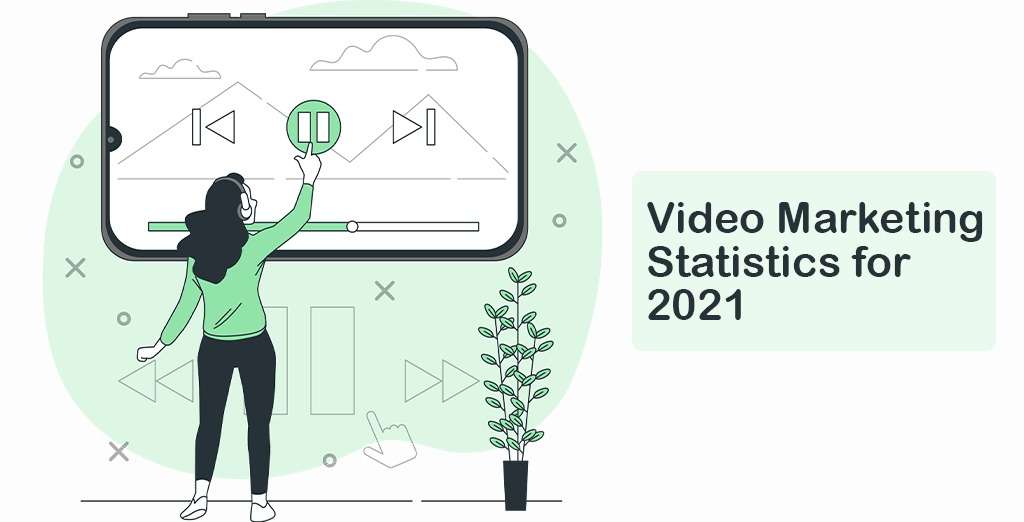Video marketing #Statistics: The State of #Videomarketing in #2021
Are you wondering whether it’s worth investing more in video marketing or not? In this article, we’ll share some key video marketing statistics that prove that now’s the proper time to make your first marketing video.
Before we dive into the stats, let’s take a fast check out a number of the kinds of videos you’ll create to plug your business.
One among the foremost common is the explainer video, which may be a short video explaining your products or services. You’ll often see explainer videos on the house page of an internet site, or a product or landing page.
Other sorts of video content marketing include:
• Vlogs (video blogs)
• Video interviews
• Tutorial videos
• Videos of presentations
• Product demos and reviews
• Video testimonials
• Recordings of live streams
• Video ads
Now, let’s get to the info on video marketing statistics.
The ROI of Video Marketing
Is video marketing worth it? Video marketing statistics show us that it’s. In their 2020 report,
Wyzowl found:
• 89% of video marketers say video gives them an honest ROI.
• 83% of video marketers say video helps them with lead generation.
• 87% of video marketers say video has increased traffic to their website.
• 80% of video marketers say video has directly helped increase sales.
• 95% of video marketers decide to increase or maintain video spending in 2022.
Animoto‘s Social Video Forecast also suggests that 91% of marketers are satisfied with the ROI of video marketing on social media.
Who’s Using Video Marketing
Another issue is how widespread video marketing is. These video marketing statistics suggest tons of individuals are using it. Wyzowl says 85% of companies use video as a marketing tool.
According to Animoto, that number is even higher with 96% of marketers having placed ad spend on video. The Content Marketing Institute’s findings are similar.
Both its B2B and B2C research for 2021 shows:
• 71% of B2B marketers use video marketing.
• 66% of B2C marketers use video marketing.
Research conducted by BreadNBeyond shows that 81% of companies use video in their marketing strategy. And Social Media Examiner’s Social Media Marketing Industry Report shows that 57% of marketers used live video in 2019.
Consumers and Online Video
So, how do consumers answer video marketing? The video marketing statistics show that they like it. Wyzowl’s research shows that folks watch a mean of 16 hours of online video per week. And, 84% of individuals say they’ve been convinced to shop for a product or service by watching a brand’s video.
According to Google, YouTube reaches more 18- to 49-year-olds in a mean week than all cable TV networks combined. Google adds that watch time for shopping-related videos on YouTube grew within the U.S. by quite 5X over the past 2 years.
Video’s also a crucial part of the shopping experience:
• More than 55% of shoppers use online video while shopping in a store, says Google.
• Wyzowl says that 66% of consumers prefer watching a video to reading a few products.
• And Hubspot says that 54% of consumers want to ascertain more video content this year.
However, it’s important to urge the tone right. In 2017, Wyzowl reported that 75% of consumers decided to not buy a product because the video voiceover annoyed them. An off-the-cuff and chatty tone is preferred by 83% of consumers.
Length matters, too, in video marketing. According to Social Media Examiner, 80% of marketers are creating videos that are 3 minutes or less. video marketing statistics show that the typical retention rate for videos across the board is 52%, but the number of time people will spend watching your videos depends on how long they’re. About 68% of individuals will watch a business video if it’s under 1 minute. Over 20 minutes? You’re getting to reach only 25% of individuals.
If you’re running video ads, a word of caution. According to research by Verizon and Publicis, 92% of consumers view videos on mute. The solution? Use captions. This same report found that 50% of consumers believe captions are better.
Mobile Video Marketing
Mobile marketing is significant to your business’s growth, and that’s obvious once you check out the research for mobile video marketing. According to IAB, ad spending in the digital video continues to extend with marketers increasing the digital video budgets by 25% year over year.
Consumers love watching videos on their mobile devices:
• According to YouTube, quite 70% of all YouTube video consumption is via mobile devices.
• Broadbandsearch says users spend 40 minutes each day, on average, watching YouTube on mobile devices.
• Wyzowl says 90% of consumers watch videos on their mobile devices.
• And 93% of Twitter video views happen on mobile.
Social Video Marketing
Lately, it looks like video, especially live video, is becoming popular on each social media site. And it’s like social media users are responding. Facebook reports that they get quite 8 billion video views daily.
Video content gets attention; that’s for sure:
• Twitter says video on Twitter is 6x as likely to be retweeted as photos.
• YouTube users upload quite 500 hours of the latest video a moment.
• Meanwhile, 1 billion hours of YouTube videos are watched daily.
While Facebook is one of the places where small businesses and professional marketers share video content, it’s not the sole important social video network. According to Animoto video marketing statistics, 90% of brands post a video on Youtube a minimum of once per week, and 83% share videos on their Instagram feed (80% share to Stories). But with quite 2 billion users, YouTube is on top.
Video Marketing Trends for 2021 and Beyond
Our research into video marketing statistics suggests that videos are going to be excellent thanks to growing your network and customer base, not just this year, but in the future.
One staggering statistic comes from Cisco:
By 2022, there’ll be almost 1,000,000 minutes of video per second crossing the web. Cisco adds that, by then, 82% of all consumer web traffic is going to be video.
There is a challenge, though. Marketers believe that video is just too time-consuming and sophisticated to supply. It doesn’t need to be, though. There are video editing tools that make creating video content super easy.
Plus, consumers want chatty and informal, remember? You don’t need to be Lucas to supply an enticing video that will thrill your audience.
These video marketing statistics show the importance of video marketing for your business, both now and in the future. So now you know what you need to do to grow your business.


